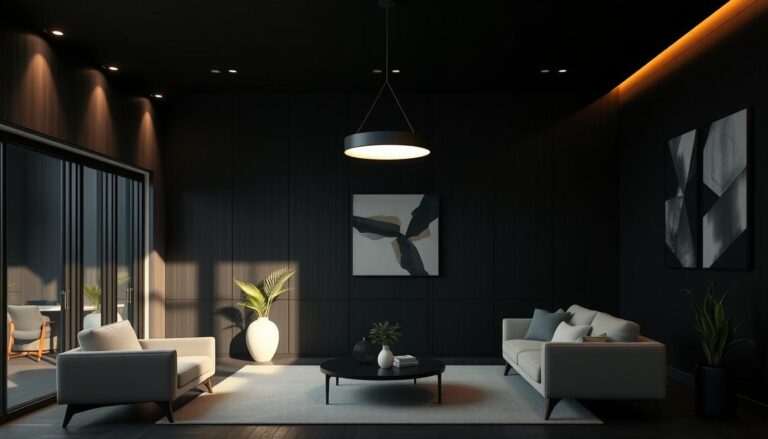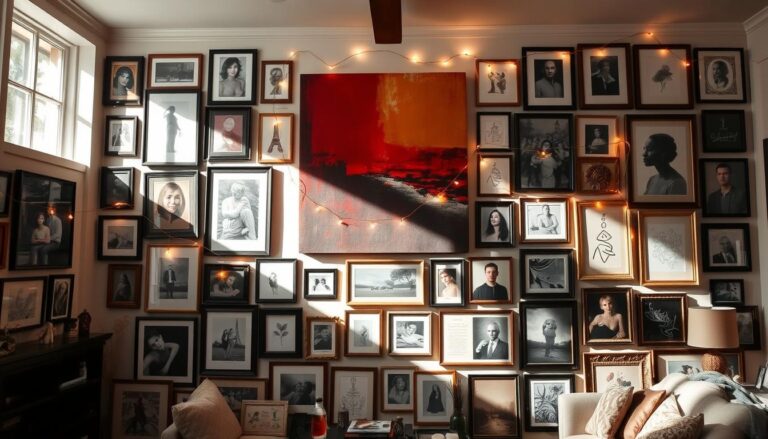Lighting is more than just a necessity; it’s a crucial element in home decor that can significantly impact our mood and the functionality of a space. As Theo Richardson aptly puts it, “The right light lifts the mood, inspires productivity, and motivates us.” A well-designed interior lighting guide can help homeowners understand how to harness the power of lighting to transform their living spaces.
Different rooms have different lighting needs, and understanding these needs is key to creating a harmonious and functional home. By selecting the appropriate lighting solutions, homeowners can enhance the ambiance of their homes, making them more welcoming and comfortable.
Key Takeaways
- Lighting affects mood and productivity.
- Different rooms require different lighting approaches.
- A well-designed lighting plan can enhance home ambiance.
- Understanding lighting needs is crucial for homeowners.
- Proper lighting solutions can make a home more welcoming.
The Fundamentals of Home Lighting
The right lighting can transform a room, making it essential to understand the fundamentals of home lighting. Effective lighting solutions can significantly enhance the ambiance and functionality of your home.
The Three Types of Lighting Every Room Needs
Every room benefits from a combination of three main types of lighting: ambient, task, and accent lighting. Ambient lighting provides overall illumination, task lighting is used for specific tasks like reading or cooking, and accent lighting highlights architectural features or decorative elements.
How Lighting Affects Mood and Functionality
Lighting can dramatically affect the mood and functionality of a room. For instance, bright lighting can make a room feel more energized, while soft, warm lighting can create a cozy atmosphere. The right lighting can also improve the functionality of a space by providing adequate light for tasks.
The Importance of Layered Lighting
Layered lighting involves combining different light sources to create a versatile and inviting atmosphere. This approach allows for flexibility in lighting levels and can be adjusted based on the activity or time of day. A well-designed layered lighting plan can significantly enhance the overall ambiance of a room.
| Lighting Type | Purpose | Examples |
|---|---|---|
| Ambient | Overall Illumination | Ceiling Fixtures, Chandeliers |
| Task | Specific Tasks | Desk Lamps, Under-Cabinet Lighting |
| Accent | Highlight Features | Track Lighting, Picture Lights |
By understanding and implementing these lighting principles, homeowners can create spaces that are both functional and aesthetically pleasing.
Understanding Light Bulb Options
Choosing the right light bulb can significantly impact the ambiance and functionality of your home. With various types of bulbs available, it’s essential to understand their differences to make an informed decision.
LED vs. Incandescent vs. Fluorescent
When it comes to lighting your home, you have several options: LED, incandescent, and fluorescent bulbs. LED bulbs are known for their energy efficiency and long lifespan, making them a popular choice. Incandescent bulbs, on the other hand, provide a warm, traditional glow but are less energy-efficient. Fluorescent bulbs fall somewhere in between, offering a balance between energy savings and light quality.
- LED: Energy-efficient, long-lasting
- Incandescent: Warm glow, less energy-efficient
- Fluorescent: Balance between energy savings and light quality
Color Temperature and Brightness
Color temperature and brightness are crucial factors in selecting the right bulb. Color temperature is measured in Kelvin (K) and can range from warm white (2700K-3000K) to cool white (3500K-5000K). Brightness, measured in lumens, determines how much light the bulb emits. For task-oriented areas like kitchens, a brighter, cooler light is often preferred, while bedrooms may benefit from softer, warmer tones.
Energy Efficiency and Lifespan Considerations
When choosing a light bulb, it’s essential to consider both energy efficiency and lifespan. LEDs, for example, are not only energy-efficient but also have a significantly longer lifespan compared to incandescent bulbs. This makes them a cost-effective option in the long run, despite their higher upfront cost.
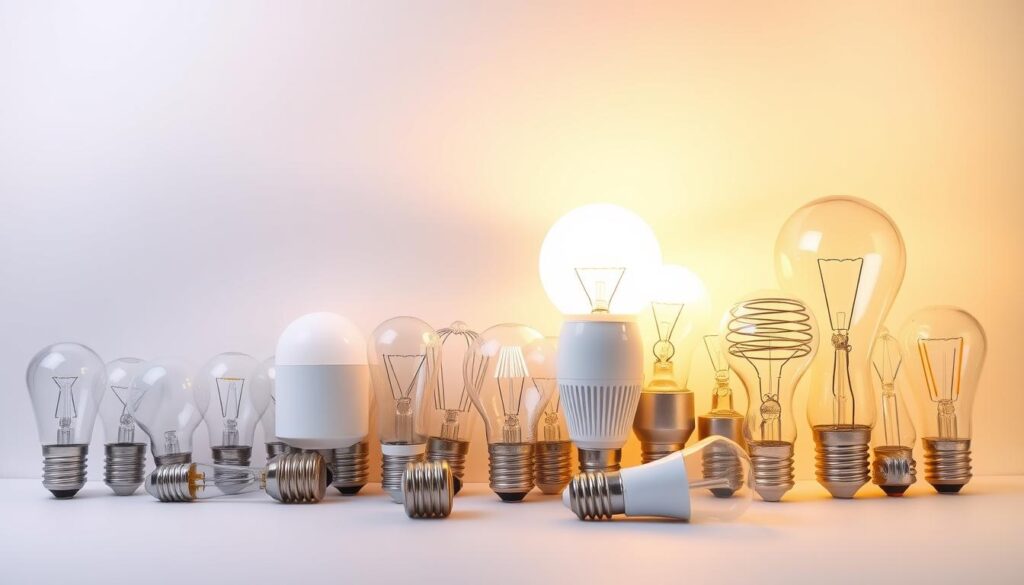
Choosing the Right Lighting for Every Room: A Comprehensive Approach
To achieve the perfect ambiance in every room, it’s essential to consider a comprehensive lighting strategy. This involves understanding the unique characteristics of each space and how lighting can enhance its functionality and aesthetic appeal.
Assessing Natural Light Sources
The first step in designing a lighting plan is to assess the natural light available in each room. Rooms with plenty of natural light during the day may require different lighting solutions compared to those with limited natural light. Consider the orientation of your windows and the time of day when natural light is most abundant.
Matching Lighting to Room Function
Different rooms have different functions, and the lighting should reflect this. For instance, task lighting is crucial in areas like kitchens and home offices, where specific activities are performed. In contrast, ambient lighting is more suitable for living rooms and bedrooms, where the focus is on creating a relaxing atmosphere.
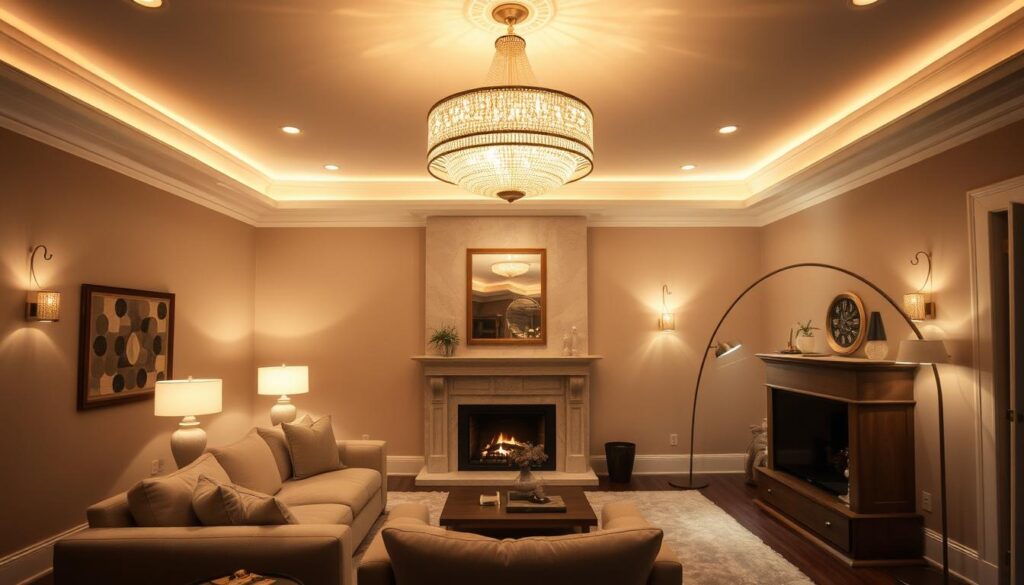
Creating Lighting Layers
A layered lighting approach involves combining different light sources to achieve a balanced and versatile lighting scheme. This typically includes a mix of ambient, task, and accent lighting. Layered lighting allows for flexibility and can significantly enhance the overall ambiance of a room.
Fixture Styles and Design Cohesion
The style and design of lighting fixtures should complement the overall décor of the room. Choosing fixtures that align with the room’s aesthetic can create a cohesive look and enhance the space’s visual appeal. Consider factors like the color scheme, furniture style, and architectural elements when selecting lighting fixtures.
| Room Type | Primary Lighting Need | Suggested Fixture Style |
|---|---|---|
| Living Room | Ambient Lighting | Table lamps, Floor lamps |
| Kitchen | Task Lighting | Under-cabinet lighting, Pendant lights |
| Bedroom | Ambient and Task Lighting | Bedside lamps, String lights |
By considering these factors and adopting a comprehensive approach to lighting, you can create a well-lit and inviting home that meets your needs and enhances your living experience.
Living Room Lighting Solutions
The living room is often considered the heart of the home, and its lighting can make or break the atmosphere. A well-designed lighting plan can transform this space into a cozy retreat or a vibrant entertainment hub.
Creating a Welcoming Atmosphere
To create a welcoming atmosphere, it’s essential to layer your lighting. This involves combining different light sources to achieve a balanced effect. Start with ambient lighting, such as ceiling fixtures, to provide overall illumination. Then, add task lighting, like table lamps, to serve specific needs. Finally, incorporate accent lighting to highlight decorative elements or architectural features.
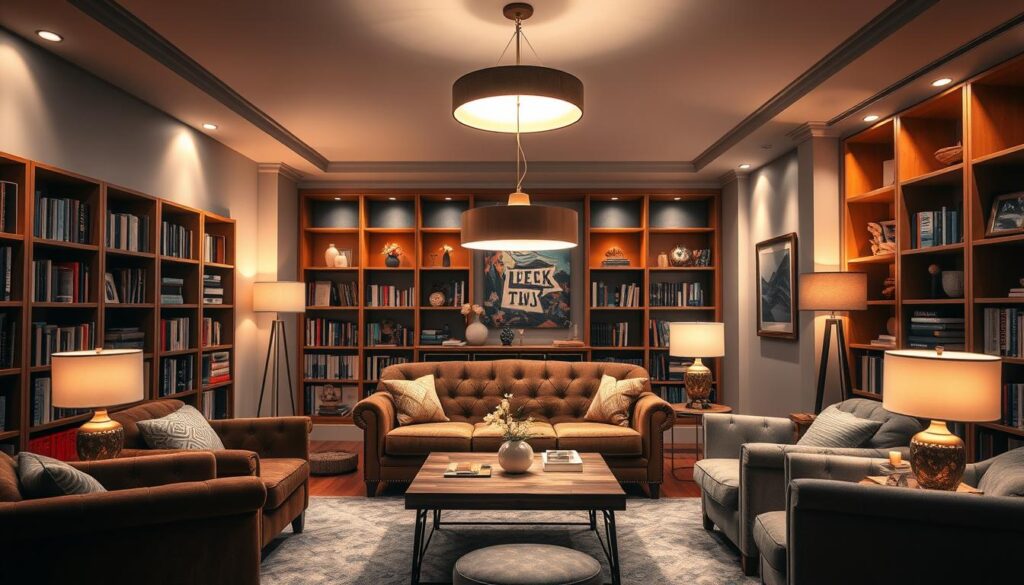
Highlighting Architectural Features
Architectural features like built-in shelves, staircases, or artwork can be accentuated with targeted lighting. Use spotlights or picture lights to draw attention to these elements. This not only enhances the room’s aesthetic but also creates visual interest.
Recommended Fixture Types and Placement
Choosing the right fixtures and placing them correctly is crucial for effective living room lighting.
Floor and Table Lamps
Floor and table lamps are versatile and can be used to create pools of light where needed. Place them in corners or beside seating areas to create a cozy ambiance. Consider lamps with adjustable arms to direct light precisely where it’s needed.
Ceiling and Wall Fixtures
Ceiling fixtures, such as chandeliers or recessed lighting, provide overall illumination. Wall fixtures, like sconces, can add layers of light and create a warm glow. When placing ceiling fixtures, consider the room’s layout and the height of the ceiling to ensure the light is distributed evenly.
By combining these lighting solutions and considering the specific needs of your living room, you can create a space that is both functional and inviting.
Kitchen Lighting That Works
A well-designed kitchen lighting plan can significantly enhance the overall kitchen experience. It’s not just about illuminating the space; it’s about creating a functional and welcoming atmosphere that meets the needs of various kitchen activities.
Task Lighting for Food Preparation
Task lighting is essential in areas where food preparation occurs, such as countertops and sinks. Under-cabinet lighting is particularly effective as it provides direct illumination to these areas, reducing shadows and improving visibility.
Ambient Lighting for Dining Areas
Ambient lighting sets the overall mood in the kitchen, especially in dining areas. It helps create a warm and inviting atmosphere, making the space more enjoyable for family meals and social gatherings.
Under-Cabinet and Island Lighting
Under-cabinet lighting not only serves as task lighting but also adds a layer of depth to the kitchen. Pendant lights over kitchen islands are both functional and stylish, providing focused lighting where it’s needed.
Pendant Lighting Placement
When installing pendant lights over a kitchen island, consider the height and spacing. Ideally, pendants should be centered over the island and spaced evenly apart.
Recessed Lighting Patterns
Recessed lighting can be used to create a grid pattern or to highlight specific areas of the kitchen. It’s essential to plan the layout carefully to avoid dark spots and ensure even illumination.
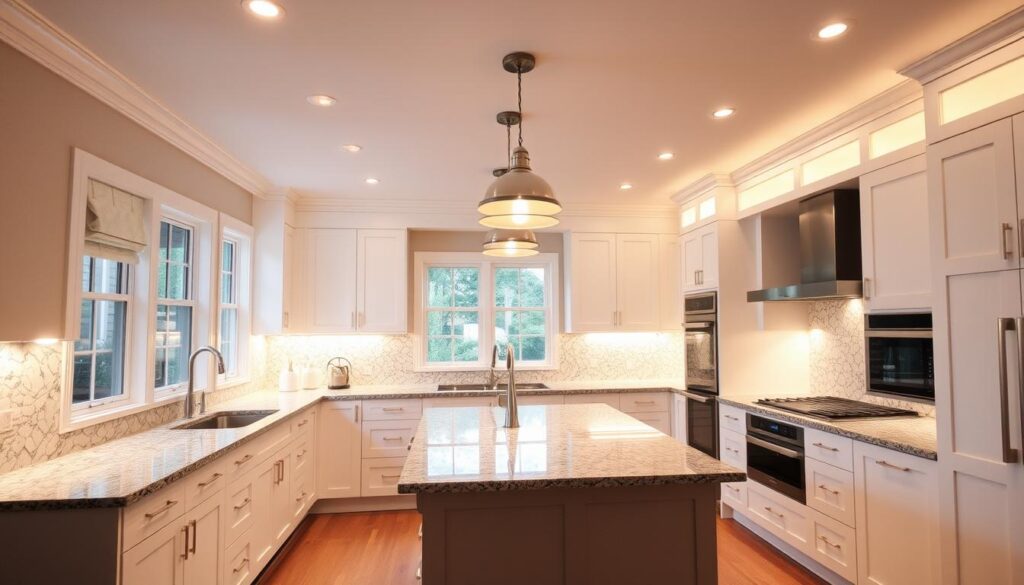
By combining task, ambient, and accent lighting, you can create a kitchen that is both functional and aesthetically pleasing. Effective kitchen lighting enhances the overall kitchen experience, making it a more enjoyable space for cooking, dining, and socializing.
Bedroom Lighting for Comfort and Function
The right lighting can transform your bedroom into a haven of relaxation and comfort. Achieving the perfect balance between ambiance and functionality is crucial for a restful retreat.
Creating a Relaxing Environment
Soft, warm lighting can significantly enhance the relaxing ambiance of your bedroom. Consider using dimmer switches to adjust the light levels according to your needs, creating a calm atmosphere that’s perfect for unwinding.
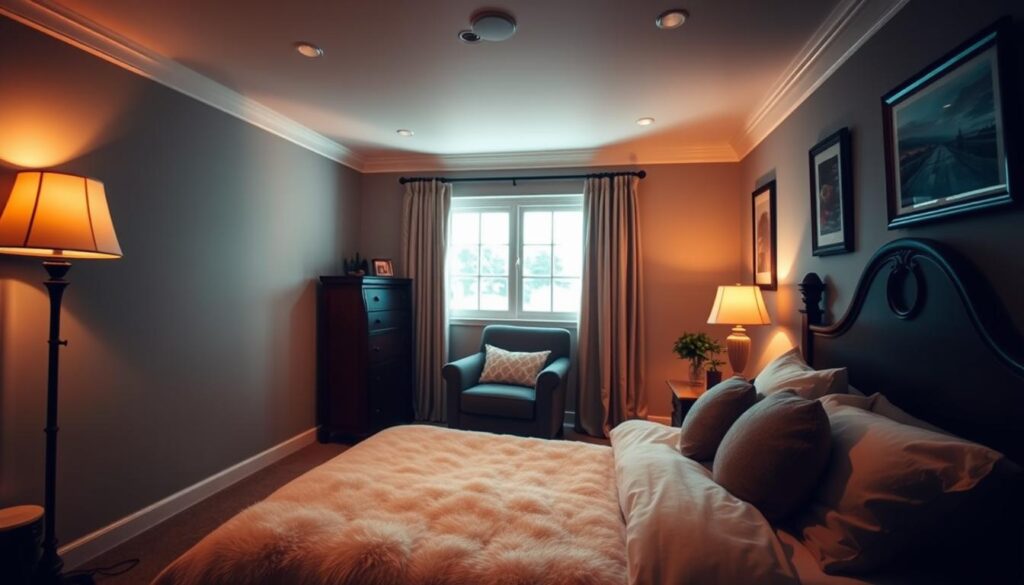
Reading and Task Lighting Options
In addition to ambient lighting, task lighting is essential for activities like reading. Bedside lamps are a popular choice, providing focused light exactly where it’s needed without disturbing others.
Closet and Vanity Lighting
Adequate lighting in closets and around vanity areas is often overlooked but is crucial for both functionality and safety. Consider installing LED strip lights in your closet for a modern and efficient lighting solution.
Bedside Lighting Solutions
When it comes to bedside lighting, there are several options to choose from, including table lamps, wall-mounted sconces, and pendant lights. The key is to select fixtures that complement your bedroom’s décor while providing the necessary light for reading and other tasks.
By carefully considering your bedroom’s lighting needs and incorporating a mix of ambient, task, and accent lighting, you can create a space that is both comfortable and functional.
Bathroom Lighting Essentials
Bathroom lighting is not just about illumination; it’s about creating an ambiance that enhances the overall bathroom experience. Effective lighting can make a significant difference in how the bathroom looks and feels.
Vanity Lighting That Flatters
Vanity lighting is crucial for tasks such as grooming and applying makeup. LED light strips or sconces on either side of the mirror can provide even, shadow-free lighting, reducing the appearance of imperfections.
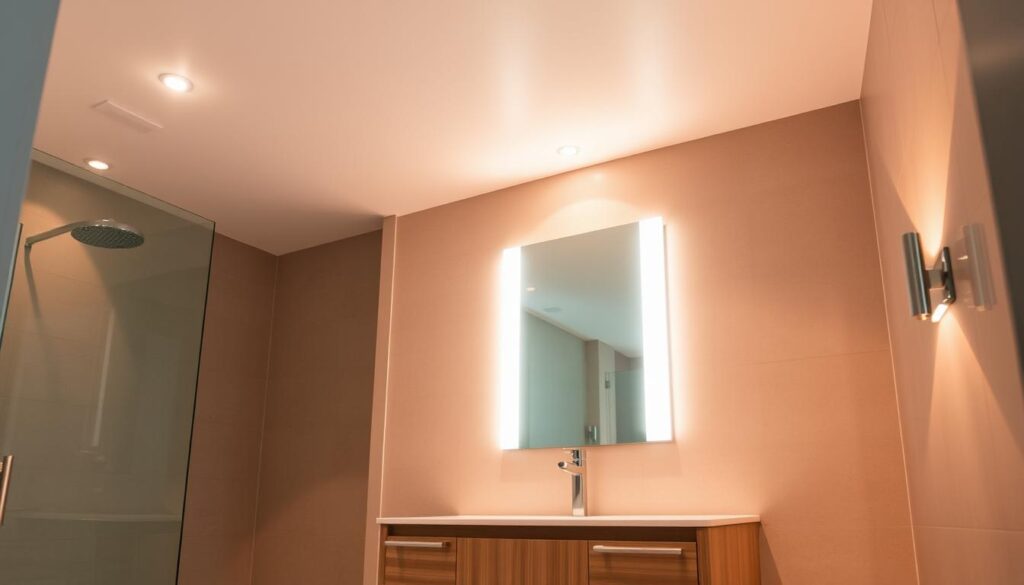
Shower and Tub Lighting
Lighting in the shower or around the tub can add a touch of luxury to the bathroom. Waterproof LED lights or recessed lighting can be used to create a spa-like ambiance. It’s essential to choose fixtures that are rated for wet locations to ensure safety.
Safety Considerations for Wet Areas
Safety is paramount in wet areas. Using fixtures with proper ratings for moisture is crucial to prevent electrical hazards.
Proper Fixture Ratings for Moisture
Fixtures should be rated for the level of moisture they will be exposed to. For example, areas around the shower or tub require fixtures with a higher IP (Ingress Protection) rating. Understanding these ratings can help in selecting the right fixtures for wet areas.
By considering these aspects of bathroom lighting, homeowners can create a space that is both functional and aesthetically pleasing.
Dining Room and Home Office Lighting
Lighting for dining rooms and home offices requires a thoughtful approach to create the perfect ambiance and functionality. Whether you’re looking to create an inviting dining space or a productive workspace, the right lighting can make all the difference.
Dining Room Chandelier Selection and Placement
A chandelier can be a stunning centerpiece in a dining room. When selecting the perfect lighting fixtures, consider the size of your dining table and the height of your ceiling. A general rule is to choose a chandelier that is about 12 inches smaller in diameter than the dining table.
Creating Ambiance for Entertaining
To create an inviting atmosphere, consider using dimmer switches to adjust the lighting levels according to the occasion. This flexibility allows you to transition from a bright, cheerful setting during the day to a more subdued, intimate ambiance in the evening.
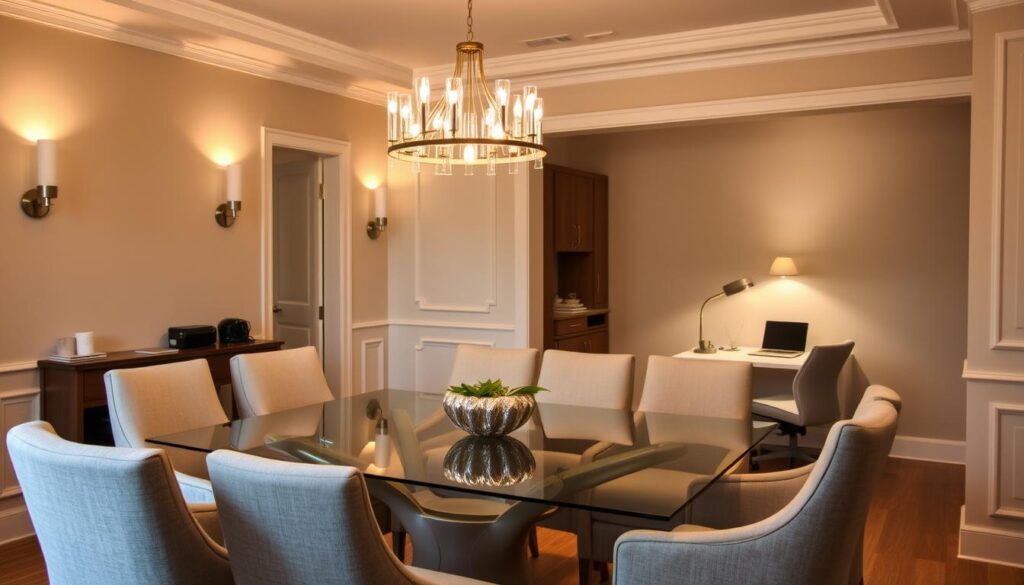
Desk and Computer Lighting for Productivity
In home offices, task lighting is crucial for productivity. Position your desk lamp to minimize glare on your computer screen and provide sufficient light for reading and writing tasks.
Video Conference Lighting Tips
For video conferencing, ensure that the lighting is even and flattering. Avoid placing your computer in front of a window, as this can cause harsh backlighting. Instead, use a desk lamp or adjust your overhead lighting to illuminate your face evenly.
Outdoor and Entryway Lighting
Effective outdoor and entryway lighting solutions not only illuminate your home’s exterior but also boost its curb appeal and security. Outdoor lighting plays a significant role in enhancing the overall appearance of your home while providing necessary illumination for safety and security.
Security and Safety Considerations
Outdoor lighting is crucial for deterring intruders and ensuring the safety of your family and guests. Motion-sensitive lights are an excellent option as they can surprise potential intruders and alert homeowners to their presence. Additionally, lighting around entry points such as doors and windows can significantly enhance security.
For safety, it’s essential to illuminate pathways, stairs, and porches to prevent accidents. LED lights are a popular choice for outdoor use due to their energy efficiency and durability.
Creating Curb Appeal
Outdoor lighting can dramatically enhance your home’s curb appeal by highlighting its best features. Accent lighting can be used to draw attention to architectural details, landscaping, or outdoor living areas, creating a welcoming ambiance.
Strategically placing lights along pathways and around gardens can also add to the aesthetic appeal of your home’s exterior. Consider using solar-powered lights for an eco-friendly option that reduces energy costs.
Weather-Resistant Fixture Options
When selecting outdoor lighting fixtures, it’s crucial to choose options that are weather-resistant. Look for fixtures with an IP65 rating or higher, indicating they are dust-tight and protected against water jets, making them suitable for outdoor use.
Materials such as stainless steel, aluminum, and weather-resistant plastics are ideal for withstanding various weather conditions. Ensure that any electrical components are properly sealed to prevent water ingress.
Pathway and Landscape Lighting
Pathway lighting not only enhances safety by illuminating walkways but also adds to the visual appeal of your home’s exterior. Solar-powered pathway lights are a convenient and energy-efficient option.
Landscape lighting can be used to highlight trees, gardens, and other outdoor features. Techniques such as uplighting and downlighting can create dramatic effects, adding depth and dimension to your outdoor spaces.
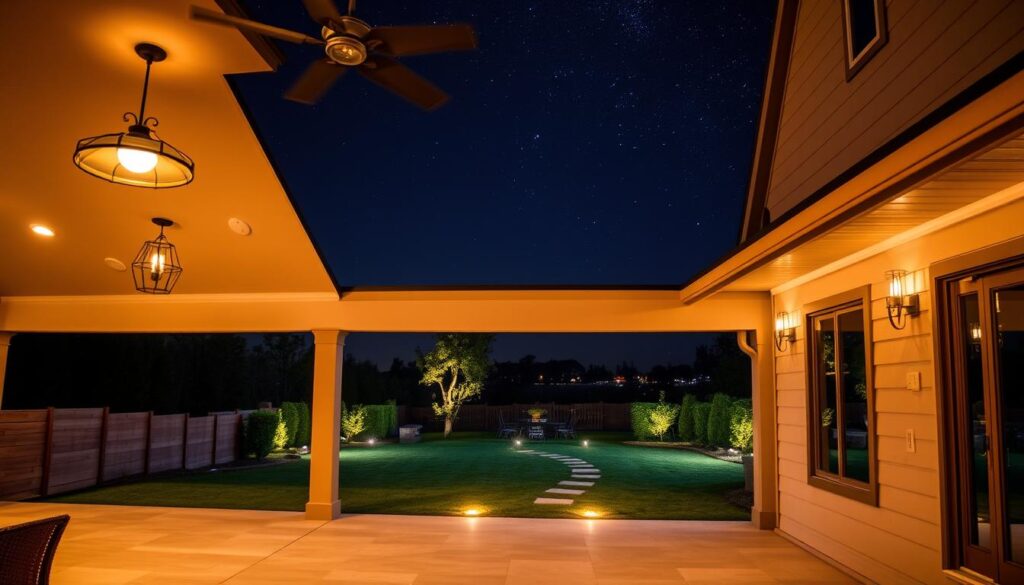
Smart Lighting Systems and Integration
Smart lighting systems are at the forefront of home automation, offering a sophisticated way to control and customize room illumination options. These systems provide a blend of convenience, energy efficiency, and enhanced home security.
Voice and App-Controlled Options
One of the key benefits of smart lighting is the ability to control your lights using voice commands or through a mobile app. This feature allows for easy adjustment of lighting levels and colors, enhancing the overall ambiance of your home.
Scheduling and Automation Benefits
Smart lighting systems enable you to schedule your lights to turn on or off at specific times, creating the illusion of occupancy when you’re away. This automation not only enhances security but also contributes to energy savings.
Integration with Other Smart Home Features
Smart lighting can be integrated with other smart home devices, such as thermostats and security cameras, to create a seamless and connected living experience.
Popular Smart Lighting Brands and Systems
| Brand | Features | Compatibility |
|---|---|---|
| Philips Hue | Color changing, scheduling | Amazon Alexa, Google Home |
| LIFX | Color changing, effects | Amazon Alexa, Google Home, Apple HomeKit |
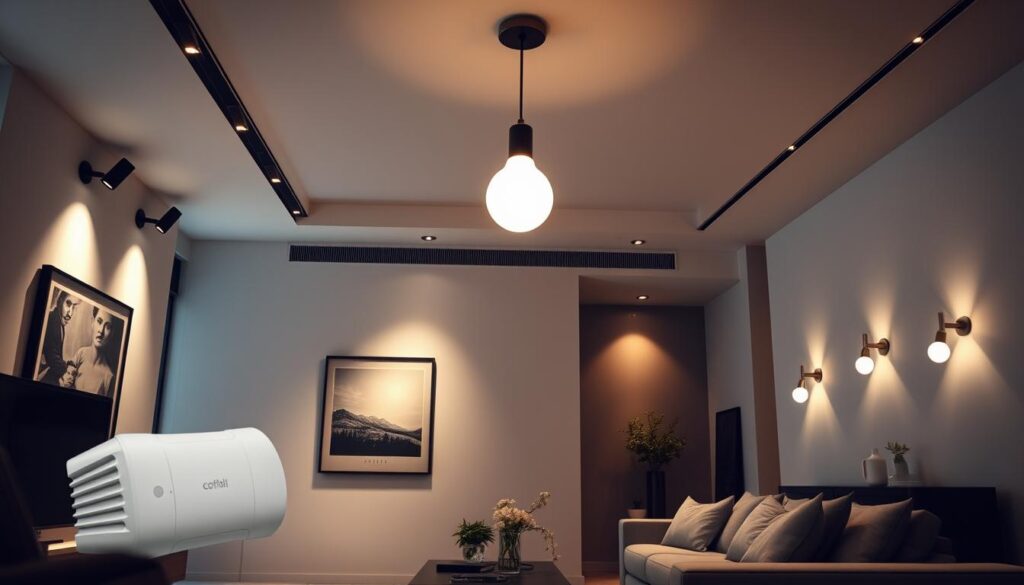
Conclusion: Illuminating Your Home with Confidence
Choosing the right lighting for every room is a crucial aspect of home design, significantly impacting the ambiance, functionality, and overall aesthetic of your living space. By understanding the fundamentals of lighting and applying the tips provided in this interior lighting guide, homeowners can create a harmonious and inviting atmosphere.
Effective lighting solutions involve layering different types of lighting, considering the specific needs of each room, and selecting fixtures that complement your home’s style. Whether you’re looking to create a warm and cozy atmosphere in your living room or bright and functional lighting in your kitchen, the right lighting can make all the difference.
With the knowledge gained from this guide, you’re now equipped to illuminate your home with confidence. By implementing these lighting solutions, you’ll not only enhance the beauty of your home but also improve its functionality and comfort. So, go ahead and brighten up your living space with the perfect lighting.

